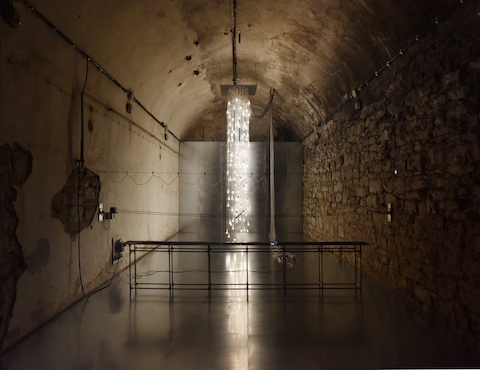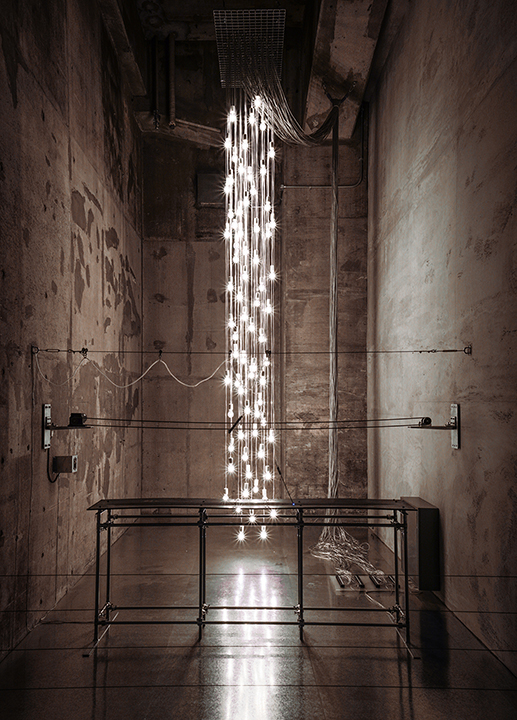Tamura Satoru

Born in 1972 in Tochigi, Japan, where he continues to live and work today, Tamura Satoru graduated from the University of Tsukuba School of Art and Design in 1995. Tamura’s practice makes frequent use of electricity, an essential element of modern civilization and a key part of its social infrastructure. At times, it endlessly rotates a sculpted crocodile; at others, it powers an instrument that quantifies beauty or illuminates a lamp with a deliberately engineered open light switch. Such ironic futility might make the viewer instinctively murmur “So what?,” but Tamura’s dynamic, large-scale devices possess a captivating energy akin to amusement park rides. The works embody what the artist describes as his “desire to break free from the meanings, frameworks, and functions that all materials and forms inherently carry.”
Electricity is so deeply embedded in our industrial operations and daily routines that we now take it for granted; only during a blackout are we able to recognize just how reliant we have become. With touches of cynical humor, Tamura uses one of humanity’s most vital resources to create objects that are completely useless and unproductive. The resulting works perfectly encapsulate the essence of fine art, which rejects any purpose other than being viewed. At the same time, they present apprehension for a society that pursues utility and efficiency at all costs.
Tamura’s recent solo exhibitions include Aimless Machine, DH Neology (Tainan, 2024); Hi, Kumi. Hi, Mike., North Gallery at Plaza North (Saitama, 2024); Becoming 1 Ton, Tamura Satoru, Tochigi City Art Museum (Tochigi, 2022); Don’t Ask Why the Crocodiles Spin, MAKI Gallery (Tokyo, 2022); and Spinning Crocodiles, Tamura Satoru, The National Art Center, Tokyo (Tokyo, 2022). He has participated in group exhibitions at such institutions as the Tokyo Photographic Art Museum, Kawamura Memorial DIC Museum of Art, Tochigi Prefectural Museum of Fine Arts, and MoMA PS1. The artist has also received numerous awards, including the International Light Art Award: First Prize (2017), The 12th Taro Okamoto Award for Contemporary Art Special Prize (2009), Philip Morris K.K. Art Award 2002: The First Move P.S.1 Art Award Special Prize (2002), and the KIRIN CONTEMPORARY AWARD Encouragement Prize (1999).
Artworks
-

Tamura Satoru, TOKYO machine, 2021, glass,steel, chain, bearing, motor, and others, 102.0 x 390.0 x 60.0 cm -

Tamura Satoru, 0 machine, 2017, steel, chain, bearing, motor, and others, 68.0 x 41.0 x 43.0 cm -

Tamura Satoru, Thunder machine, 2020, steel, chain, bearing, motor, and others, 65.0 x 40.0 x 14.0 cm -

Tamura Satoru, ART machine #2, 2016, steel, chain, bearing, motor, and others, 52.5 x 65.0 x 22.5 cm -

Tamura Satoru, LOVE machine#2, 2014, steel, chain, bearing, motor, and others, 71.5 x 43.0 x 40.0 cm, Photo: Yamazaki Yuji -

Tamura Satoru, Spin Crocodile Garden, 1994-2013, mixed media, dimensions variable, Photo: Kigure Shinya -

Tamura Satoru, Point of Contact #3, 2020, mixed media, Installation size variable -

Tamura Satoru, Point of Contact for 50 Incandescent Lamps #10, 2018, mixed media, 223.5 x 315.0 x 164.3 cm (Installation size variable) -

Tamura Satoru, Point of Contact for 20 Incandescent Lamps #4, 2014, mixed media, 23.0 x 99.5 x 11.0 cm -

Tamura Satoru, Point of Contact for 10 Incandescent lamps, 2018, mixed media, 50.0 x 50.0 x 10.0 cm -

Tamura Satoru, Point of Contact for 21 Incandescent Lamps, 2016, mixed media, 53.5 x 38.5 x 11.0 cm -

Tamura Satoru, Point of Contact for Incandescent Lamp #22, 2017, mixed media, 18.0 x 30.0 x 27.5 cm



